
Swangrove is a Grade I listed country house in Hawkesbury, South Gloucestershire, England. The listing includes Swangrove House, its garden walls, four corner pavilions, and gate piers. It was built in 1703 by William Killigrew of Bath. [1]

Swangrove is a Grade I listed country house in Hawkesbury, South Gloucestershire, England. The listing includes Swangrove House, its garden walls, four corner pavilions, and gate piers. It was built in 1703 by William Killigrew of Bath. [1]

Badminton House is a large country house and Grade I Listed Building in Badminton, Gloucestershire, England, which has been the principal seat of the Dukes of Beaufort since the late 17th century. The house, which has given its name to the sport of badminton, is set among 52,000 acres of land. The gardens and park surrounding the house are listed at Grade I on the Register of Historic Parks and Gardens.

Redland is a neighbourhood in Bristol, England. The neighbourhood is situated between Clifton, Cotham, Bishopston and Westbury Park. The boundaries of the district are not precisely defined, but are generally taken to be Whiteladies Road in the west, the Severn Beach railway line in the south and Cranbrook Road in the east.

Stowell Park Estate is a 6,000-acre (24 km2) historic agricultural and sporting estate in the Cotswold Hills, Gloucestershire, England. The estate includes the village of Yanworth. The main house is a Grade II* listed building and surrounded by extensive parkland, a mill, and church. The landscaped park is listed Grade II on the Register of Historic Parks and Gardens.

Lydney Park is a 17th-century country estate surrounding Lydney House, located at Lydney in the Forest of Dean district in Gloucestershire, England. It is known for its gardens and Roman temple complex.

Acton Court is the historic manor house of the manor of Iron Acton in Gloucestershire, England. It is a grade I listed building of Tudor architecture and was recently restored. It is situated, at some considerable distance from the village of Iron Acton and the parish church of St Michael, on Latteridge Lane, Iron Acton, South Gloucestershire, England. The Poyntz family owned the property from 1364 until 1680. Nicholas Poyntz added the East Wing onto the existing moated manor house shortly before 1535. Construction took about 9 months to complete. Subsequently, the wing was lavishly and fashionably decorated to impress Henry VIII. The king and his second wife, Anne Boleyn, stayed in the house in 1535, during a tour of the West Country. Building work continued at Acton Court until Nicholas died in 1557.

Dodington Park is a country house and estate in Dodington, South Gloucestershire, England. The house was built by James Wyatt for Christopher Bethell Codrington. The family had made their fortune from sugar plantations in the Caribbean and were significant owners of slaves. It remained in the Codrington family until 1980; it is now owned by the British businessman James Dyson.

Cirencester Park is a country house in the parish of Cirencester in Gloucestershire, England, and is the seat of the Bathurst family, Earls Bathurst. It is a Grade II* listed building. The gardens are Grade I listed on the Register of Historic Parks and Gardens.

Boxwell Court is a country house near Leighterton in Gloucestershire, England, about 5 km or 3 miles east of Wotton-under-Edge, dating from the 15th and 16th centuries. It is a Grade II* listed building.

Sherborne House is a large house in the village of Sherborne, Gloucestershire, England. It is a former country house that has been converted into flats and has been designated by English Heritage as a Grade II* listed building.
Eastleach House is Grade II listed country house in Eastleach Martin, Gloucestershire, designed by the architect Walter Cave and completed in 1900.
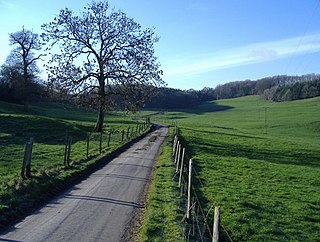
Kingscote Park is a Grade II listed house and country estate in Kingscote, near Tetbury, Gloucestershire, England. The original Kingscote Park was demolished in 1951. Both houses formed part of the manor of Kingscote which was held by the Kingscote family from the 12th century and is mentioned in the Domesday Book as 'Chingescote'.

Ebrington Manor is a grade II listed manor house in the parish of Ebrington in Gloucestershire, England. Since 1476 it has been a seat of the Fortescue family, since 1789 Earls Fortescue.

Trull House is a Grade II listed country house near the hamlet of Trull, to the north of the village of Ashley and about 3.4 miles (5.5 km) northeast of Tetbury in Gloucestershire, England.
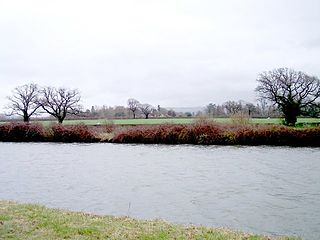
Hardwicke Court is a Grade II* listed country house in Hardwicke, Gloucestershire, England. The house is Late Georgian in style. It was designed by Sir Robert Smirke and built in 1816–17, although a canal still remains from the early 18th-century gardens of the Trye family. Hardwicke Court was built for Thomas John Lloyd Baker, widower of Mary Sharp. A bust of Sharp's uncle, abolitionist Granville Sharp, is on display at the house.
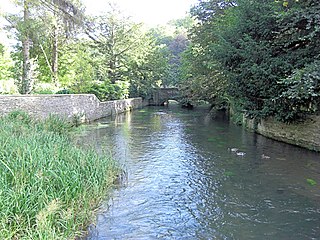
Ablington Manor is a Grade I listed country house in Potlicker's Lane, Ablington within the parish of Bibury, Gloucestershire, England. The estate was owned by the Howse family, until John Coxwell purchased it in 1574. Coxwell built the house in 1590, and alterations and additions were added in around 1780. The house is a Grade I listed building.

Frampton Court is a Grade I listed country house and estate of about 1,500 acres (610 ha) in Frampton-on-Severn, Gloucestershire, England. It has been owned by the Clifford family since the 11th century. The main buildings are the 18th century Frampton Court and, on the opposite side of the village green, Manor Farm. The gardens at Frampton Court have a Gothic orangery and ornamental canal in the style of William Halfpenny. The two houses, barn and orangery are all Grade I listed buildings in their own right, while the Gatepiers and Gates are Grade II* listed.
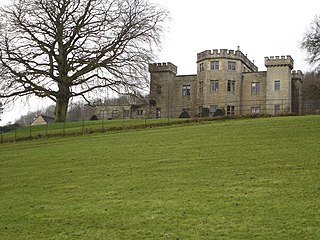
Lasborough Park is a Grade II listed country house in Newington Bagpath/Lasborough, Tetbury, Gloucestershire, England. The estate includes a medieval manor, a house, and parkland. The original medieval manor, Lasborough Farm, dates to the 11th century, and included terraced gardens. A manor house is record in the 14th century. The manor was surrounded by woodland and a deer park. Lasborough House and its pleasure grounds was built in 1794.
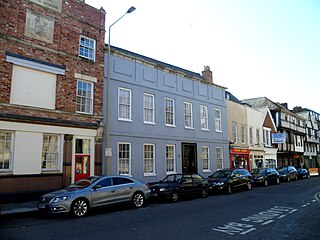
Hyatt House, or Hyett House, is a grade II listed building at 91 Westgate Street in the English city of Gloucester. The building is of a timber frame with stone and was probably constructed in the 16th century. According to a plaque on the building, an earlier dwelling stood on the site at least as early as 1455. The current façade was probably constructed by Nicholas Hyett (1709–1777), a local lawyer and justice of the peace. In 1988 the building was converted to flats by Avondown Housing Association and Gloucester City Council.

Trewithen House is a Georgian country house in Probus, Cornwall, England. The Palladian house was built by London-based architect Thomas Edwards in 1723. The house is listed Grade I on the National Heritage List for England, and its gardens are Grade II* listed on the Register of Historic Parks and Gardens.

Abbotswood is a country house and estate near Lower Swell in Gloucestershire, England. It is a grade II listed building and estate, of medieval origins and with remodelling and garden work to the designs of Sir Edwin Lutyens from 1901 onwards.
51°34′13″N2°17′39″W / 51.5703°N 2.2942°W